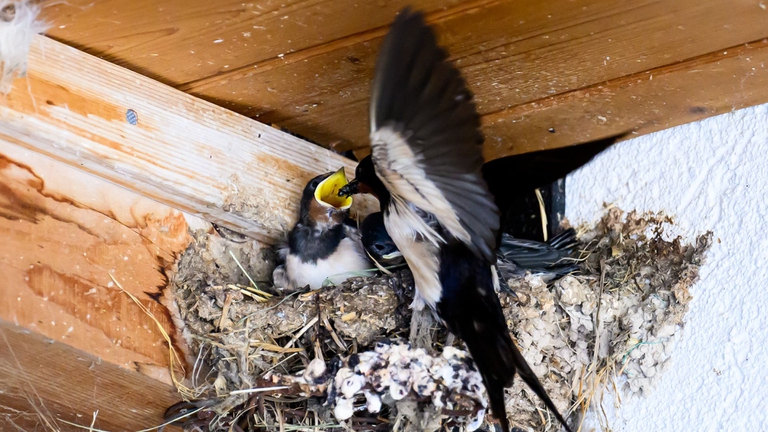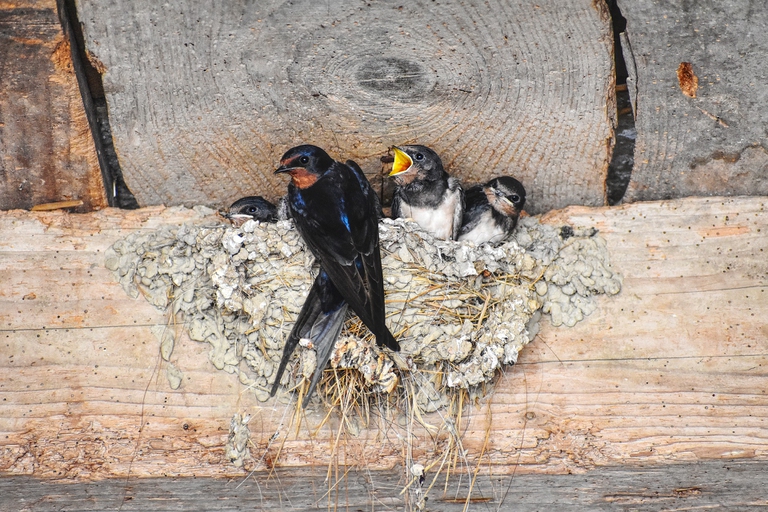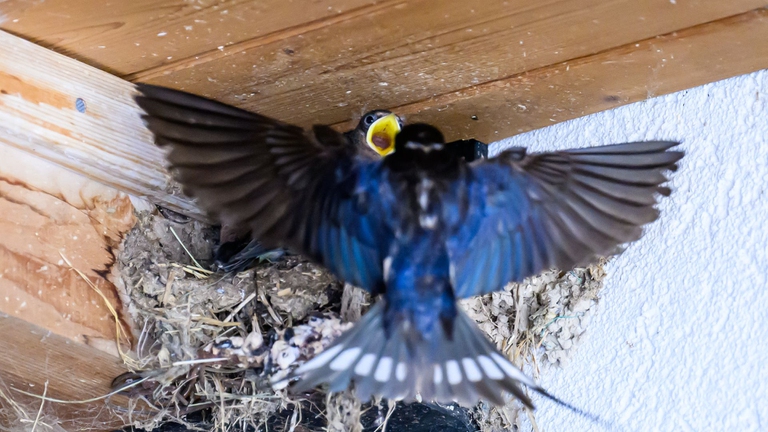https://www.lifegate.it/rondini-allevamenti
- |
Men and swallows intertwine their destinies for thousands of years, as evidenced by the countless traces that this charismatic migratory bird, with its unmistakable forked tail, has left in our culture, from ancient times to today.
In ancient Greece, for example, the swallow, by virtue of the coincidence of its arrival with that of spring, was linked to the cult of annual regeneration.English sailors instead used to tattoo a swallow, like good omen to return home after long voyages.
They are also present in numerous cultures taboo for those who kill or harm swallows.According to Estonian beliefs, if someone kills a swallow he becomes blind, while in Anglo-Saxon culture it is believed that damaging a swallow's nest on your farm causes damage to the livestock present.Many in Italy too popular beliefs they link mistreatment of swallows to nefarious or unfortunate events.
For this reason the swallow (Hirundo rustica) will never be, for us, a bird like the others.

A new scientific study has provided a further element to love and take care of swallows, allowing us to cross natural sciences and cultural anthropology and to look at these beliefs and social conditioning from another perspective.
Rondini, an ally for farmers
The study, titled “The Landscape of Fear on Cattle Farms?How the presence of the swallow influences the activity of harmful flies”, was conducted by Muses, the Science Museum of Trento, Lipu and the University of Milan and published in the Journal of applied ecology.
The research studied, in particular, the ecological role of swallows in the cattle farms of Val di Non, in Trentino, to understand the effect that the presence of birds can have on the activity rate of flies, their potential prey and vectors of numerous pathogens and a source of stress for farmed livestock.
The abundance of swallows and flies was measured for 16 weeks in nine different farms in Val di Non, occupied or not by nesting swallows.If on the one hand it is known the valuable ecosystem control service of parasites offered by predators in agriculture, on the other hand the role of insectivorous birds in farming is still little studied.
Stable sweet stable
The swallows, particularly adaptable species, have co-evolved with humans, finding a safe haven in man-made structures.
“The swallow now nests almost exclusively on human structures – explained Francesca Roseo, researcher at the Muse Conservation Biology office.At the time of the transition from the condition of hunter-gatherer to that of sedentary farmer, the swallows adapted by starting to build nests on artificial walls."
They indeed found it particularly favorable conditions:a safe wall without predators, the presence of livestock and pasture and, consequently, insects to feed on.
“The stables now almost represent the last bastion on which swallows are able to nest more or less undisturbed.Our study focused on stables of extensive breeding, examining stables in which there is the presence of swallows and stables from which they are absent".
A natural fly killer
To quantify the contribution of swallows in the control of flies harmful to livestock, the researchers compared the seasonal increase in fly activity rates in a geographically and environmentally homogeneous area, but with a variability in the presence and abundance of swallows.
“We found, around the peak of the reproduction of the species, a notable decline in the presence of flies in the stables where the swallows are present, said Roseo, both due to direct and potential predation by the birds, and for what we called landscape of fear, according to which the presence of swallows would discourage that of insects".
The study revealed how the activity rate of flies increases with temperature, this increase, however, is much less marked in the presence of swallows.At a temperature of 22 degrees, the study reports, the local presence of 25 swallows corresponds to an average reduction of more than 60 percent in the activity rate of flies compared to what you would have in a stable without swallows.
The presence of swallows in stables therefore represents a favorable scenario for both birds and farmers:“The former can reproduce and raise their young in a safe environment, with food and controlled temperature, while the latter have less need to carry out treatments to contain the number of flies,” continues Roseo.

The landscape of fear
The reduction in the presence and activity of flies is therefore due to potential direct predation by insectivorous birds, and therefore also to the establishment of a "landscape of fear".Swallows, in fact, usually feed in an area within four hundred meters of the nest, making that limited space particularly dangerous for their prey.
Other studies have shown that insects are also sensitive to calls emitted by swallows and researchers, through experimental tests, have noticed that the housefly (Housefly), withholding tax one of the worst parasites of the dairy industries, is able to evaluate the risk of predation, therefore avoiding areas with a greater density of predators.“Our results demonstrate that the risk of predation by swallows reduced the flight time of flies in the analyzed areas, thus reducing nuisance to cattle and the likelihood of disease transmission,” said the Muse researcher.
Swallows in decline
Despite the millenary link with Homo sapiens and the obvious ecosystem services offered by swallows, these passerine birds, which once roamed our skies in large numbers, are in serious decline.Between 1980 and 2021 in Europe, according to data from the Farmland bird index, the species has undergone a decrease of 19 percent.
The decline is mainly caused by intensive agricultural practices and from the use of chemical products such as neonicotinoids, insecticides of synthesis responsible for the decline in the populations of birds and pollinating insects that inhabit the agricultural areas of the Old Continent.To these factors must be added the degradation of habitats in sub-Saharan Africa climate crisis and prey reduction.
More wildlife, more happiness
The study reminded us, once again, how much wildlife both fundamental for our well-being, by virtue of the ecosystem services it offers us, but also for enrich our lives with its mere presence, fueling myths and stories, and playing an important cultural role.
We must return to permeate ourselves with other species, which they are not our rivals, but rather, as Baptiste Morizot writes, "living cohabitants caught up in this community of destiny which is living history".
Thus, while in Trentino farmers (re)discover the usefulness of swallows, their colleagues in Abruzzo have begun to willingly accept the return of the griffins (Gyps fulvus).“We have found a positive perception from farmers.They realized that vultures represent an ally for them.In fact, they allow them to save the costs of disposing of carcasses,” explained Nicolò Borgianni, Vulture field officer of Rewilding Apennines.
After years in which every fight against parasites has been delegated to chemical products, which have contributed to enormously impoverishing the biodiversity of our campaigns, the time has come to focus on nature-based solutions.Insectivorous birds, such as swallows, can play an important role in the biological control of insects in agroecosystems.
“We need to innovative approaches to counteract the decline of biodiversity in the agricultural and livestock sector and find synergies between human activities and the conservation of biodiversity is fundamental – said Francesca Roseo –.Furthermore, if we want to achieve the goals for the sustainability globally, we need to get serious about applying nature-based solutions.To be able to do this, we must first of all improve our scientific knowledge."

A protocol to help coexistence
Swallows therefore offer valuable help to breeders and, on the other hand, stables represent one of the last safe refuges in which these birds manage to have excellent reproductive success.Precisely to encourage the conservation of swallows in this context, e encourage the adoption of good practices on the part of the livestock facilities, "we have drawn up a protocol, which is still in the application phase, and which has the potential to be applied to over seven hundred stables", the researcher told us.
The protocol suggests the ideal timing for the different actions to be taken in the stable, both when the swallows are absent and when they are present.In the first months of the year, for example, breeders can install barriers to discourage nest building in unwanted areas, while towards the end of the year, it is possible place artificial nests in areas suitable to encourage the presence of swallows in the stable.
Humans, swallows, cattle and flies.Different creatures that coexist in a fragile but precious balance, giving life to a network of relationships which, in light of the collapse of the natural world that we have caused, require us to rethink our humanity in relation to other species.
